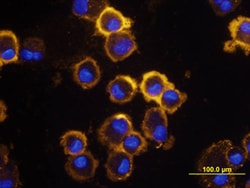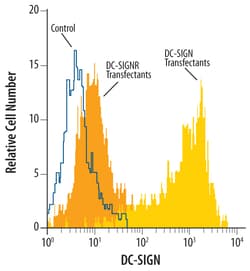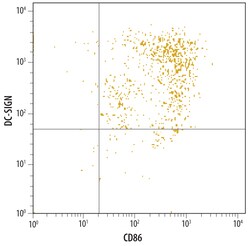Promotional price valid on web orders only. Your contract pricing may differ. Interested in signing up for a dedicated account number?
Learn More
Learn More
Human DC-SIGN/CD209 Antibody, R&D Systems™


Mouse Monoclonal Antibody has been used in 38 publications
Supplier: R&D Systems MAB161SP
This item is not returnable.
View return policy
Description
DC-SIGN/CD209 Monoclonal specifically detects DC-SIGN/CD209 in Human samples. It is validated for Western Blot, Flow Cytometry, Immunohistochemistry, Adhesion Blockade, Immunocytochemistry, CyTOF-ready.Specifications
| DC-SIGN/CD209 | |
| Monoclonal | |
| Unconjugated | |
| Lyophilized from a 0.2 μm filtered solution in PBS with Trehalose. *Small pack size (SP) is supplied as a 0.2 μm filtered solution in PBS. with No Preservative | |
| CD209 | |
| NIH-3T3 mouse embryonic fibroblast cell line transfected with human DC-SIGN/CD209 | |
| 25 μg | |
| Primary | |
| Detects human DC-SIGN/CD209 on transfected NIH/3T3 cells and on monocyte derived dendritic cells. Does not react with parental mouse cells or irrelevant transfectants, such as human DC-SIGN2. | |
| Human | |
| Purified |
| Western Blot, Flow Cytometry, Adhesion Blockade, CyTOF, Immunocytochemistry | |
| 120507 | |
| Western Blot 1 ug/mL, Flow Cytometry 2.5 ug/10^6 cells, Adhesion Blockade 5.0 ug/mL, CyTOF-ready | |
| CD209, CD209 antigendendritic cell-specific intracellular adhesion molecules (ICAM)-3 grabbingnon-integrin, CD209 molecule, CDSIGNHIV gpl20-binding protein, CLEC4L, CLEC4LC-type lectin domain family 4 member L, DCSIGN, DC-SIGN1, DC-SIGN1C-type lectin domain family 4, member L, DC-SIGNMGC129965, Dendritic cell-specific ICAM-3-grabbing non-integrin 1 | |
| Mouse | |
| Protein A or G purified from hybridoma culture supernatant | |
| RUO | |
| 30835 | |
| Reconstitute at 0.5 mg/mL in sterile PBS. | |
| Use a manual defrost freezer and avoid repeated freeze-thaw cycles. 12 months from date of receipt, -20 to -70 degreesC as supplied. 1 month, 2 to 8 degreesC under sterile conditions after reconstitution. 6 months, -20 to -70 degreesC under sterile conditions after reconstitution. | |
| IgG2b |
Product Content Correction
Your input is important to us. Please complete this form to provide feedback related to the content on this product.
Product Title
Spot an opportunity for improvement?Share a Content Correction


